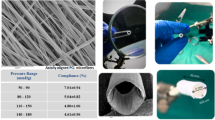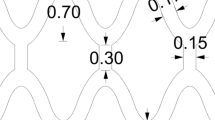Abstract
The structural integrity and arterial mechanics are important aspects for tissue regenerative vascular grafts with ingrowth permissible porous scaffolds. This paper presents a computational study of structural designs for a small-diameter vascular graft comprising porous polyurethane scaffold and knitted reinforcement mesh using Nitinol and polyurethane wire, respectively. Finite element models of the porous scaffold with the knitted mesh as embedded or external reinforcement were generated using validated constitutive models for porous polyurethane and Nitinol. Simulating a luminal pressure of up to 200 mmHg, deformations and stresses were recorded in porous scaffold and knitted mesh. The models predicted compliance between 1.2 and 15.7%/100 mmHg for the reinforced grafts and 65.1 and 106.4%/100 mmHg for the non-reinforced grafts. For the reinforced grafts, maximum stress was 97.0, 28.2, and 0.055 MPa in Nitinol wire, polyurethane wire, and porous polyurethane scaffold, respectively, at 120 mmHg. The corresponding maximum strain was 0.27, 5.0, and 22.5%. Stress and strain remained safe in the Nitinol mesh and the porous polyurethane but became critical in the polyurethane mesh between 120 and 200 mmHg. Despite compression due to luminal pressure load, the porous scaffold remained ingrowth permissible for cells, capillaries, and arterioles up to 200 mmHg. The outcomes of this study provided preliminary concepts for the structural designs for a tissue regenerative composite vascular graft toward improved mechanical performance and structural integrity. The implemented modeling approach can be used in the further development and optimization of small-diameter tissue-regenerating vascular grafts.







Similar content being viewed by others
References
Abaqus Analysis User’s Manual. Providence, RI: Abaqus, Dassault Systèmes, 2008.
Bezuidenhout, D. Porous Polymeric Superstructures as In-Growth Scaffolds for Tissue-Engineered Vascular Prostheses. PhD Thesis. Stellenbosch: Stellenbosch University, 2001.
Bezuidenhout, D., N. Davies, and P. Zilla. Effect of well defined dodecahedral porosity on inflammation and angiogenesis. ASAIO J. 48(5):465–471, 2002.
Crowley, L. V. An Introduction to Human Disease: Pathology and Pathophysiology Correlations (8th ed.). Sudbury, MA: Jones & Bartlett Publishers, 2009.
Dammak, M., A. Shirazi-Adl, and D. J. Zukor. Analysis of cementless implants using interface nonlinear friction–experimental and finite element studies. J. Biomech. 30(2):121–129, 1997.
Davies, N., S. Dobner, D. Bezuidenhout, C. Schmidt, M. Beck, A. H. Zisch, et al. The dosage dependence of VEGF stimulation on scaffold neovascularisation. Biomaterials 29(26):3531–3538, 2008.
Desai, M., J. Eaton-Evans, C. Hillery, R. Bakhshi, Z. You, J. Lu, et al. AAA stent–grafts: past problems and future prospects. Ann. Biomed. Eng. 38(4):1259–1275, 2010.
Dobrin, P., F. Littooy, J. Golan, B. Blakeman, and J. Fareed. Mechanical and histologic changes in canine vein grafts. J. Surg. Res. 44(3):259–265, 1988.
Ellozy, S. H., A. Carroccio, M. Minor, T. Jacobs, K. Chae, A. Cha, et al. Challenges of endovascular tube graft repair of thoracic aortic aneurysm: midterm follow-up and lessons learned. J. Vasc. Surg. 38(4):676–683, 2003.
Ethier, C. R., and C. A. Simmons. Introductory Biomechanics: From Cells to Organisms. Cambridge Texts in Biomedical Engineering. Cambridge: Cambridge University Press, 2007.
Fung, Y.-C. Biomechanics: Mechanical Properties of Living Tissues (2nd ed.). New York: Springer, 1993.
Gamble, J. R., L. J. Matthias, G. Meyer, P. Kaur, G. Russ, R. Faull, et al. Regulation of in vitro capillary tube formation by anti-integrin antibodies. J. Cell Biol. 121(4):931–943, 1993.
Gorman, S. P., D. S. Jones, M. C. Bonner, M. Akay, and P. F. Keane. Mechanical performance of polyurethane ureteral stents in vitro and ex vivo. Biomaterials 18(20):1379–1383, 1997.
Grapski, J. A., and S. L. Cooper. Synthesis and characterization of non-leaching biocidal polyurethanes. Biomaterials 22(16):2239–2246, 2001.
Holzapfel, G. A., T. C. Gasser, and R. W. Ogden. A new constitutive framework for arterial wall mechanics and a comparative study of material models. J. Elasticity 61(1–3):1–48, 2000.
Info Sheet No. 4: Selected properties of NiTi. Memory-Metalle GmbH, Weil am Rhein. 2006. http://www.memory-metalle.de/html/03_knowhow/PDF/MM_04_properties_e.pdf. Accessed 29/04/2010.
Jacobs, T. S., J. Won, E. C. Gravereaux, P. L. Faries, N. Morrissey, V. J. Teodorescu, et al. Mechanical failure of prosthetic human implants: a 10-year experience with aortic stent graft devices. J. Vasc. Surg. 37(1):16–26, 2003.
Kim, J. H., T. J. Kang, and W.-R. Yu. Mechanical modeling of self-expandable stent fabricated using braiding technology. J. Biomech. 41(15):3202–3212, 2008.
Kleinstreuer, C., Z. Li, C. A. Basciano, S. Seelecke, and M. A. Farber. Computational mechanics of Nitinol stent grafts. J. Biomech. 41(11):2370–2378, 2008.
Konnerth, J., W. Gindl, and U. Müller. Elastic properties of adhesive polymers. I. Polymer films by means of electronic speckle pattern interferometry. J. Appl. Polym. Sci. 103(6):3936–3939, 2007.
Levy, B., and A. Tedgui (eds.). Biology of the Arterial Wall. Dordrecht: Kluwer, 1999.
Mailhot, B., K. Komvopoulos, B. Ward, Y. Tian, and G. A. Somorjai. Mechanical and friction properties of thermoplastic polyurethanes determined by scanning force microscopy. J. Appl. Phys. 89(10):5712–5719, 2001.
Min, H. K., Y. T. Lee, W. S. Kim, J. H. Yang, K. Sung, T. G. Jun, et al. Complete revascularization using a patent left internal thoracic artery and variable arterial grafts in multivessel coronary reoperation. Heart Surg. Forum 12(5):244–249, 2009.
Mooney, D. J., D. F. Baldwin, N. P. Suh, J. P. Vacanti, and R. Langer. Novel approach to fabricate porous sponges of poly(-lactic-co-glycolic acid) without the use of organic solvents. Biomaterials 17(14):1417–1422, 1996.
Mortier, P., G. Holzapfel, M. De Beule, D. Van Loo, Y. Taeymans, P. Segers, et al. A novel simulation strategy for stent insertion and deployment in curved coronary bifurcations: comparison of three drug-eluting stents. Ann. Biomed. Eng. 38(1):88–99, 2010.
Newman Dorland, W. A. Dorland’s Illustrated Medical Dictionary (29th ed.). Philadelphia: Saunders, 2000.
Peynircioglu, B., O. Ergun, T. Hazirolan, T. Serter, I. Ucar, B. Cil, et al. Stent-graft applications in peripheral non-atherosclerotic arterial lesions. Diagn. Interv. Radiol. 14(1):40–50, 2008.
Sakai, H., K. Urasawa, N. Oyama, and A. Kitabatake. Successful covering of a hepatic artery aneurysm with a coronary stent graft. Cardiovasc. Intervent. Radiol. 27(3):274–277, 2004.
Tai, N. R., H. J. Salacinski, A. Edwards, G. Hamilton, and A. M. Seifalian. Compliance properties of conduits used in vascular reconstruction. Br. J. Surg. 87(11):1516–1524, 2000.
van der Merwe, H., B. Daya Reddy, P. Zilla, D. Bezuidenhout, and T. Franz. A computational study of knitted Nitinol meshes for their prospective use as external vein reinforcement. J. Biomech. 41(6):1302–1309, 2008.
Wiggins, M. J., J. M. Anderson, and A. Hiltner. Biodegradation of polyurethane under fatigue loading. J. Biomed. Mater. Res. A 65A(4):524–535, 2003.
Wong, G., J.-M. Li, G. Hendricks, M. H. Eslami, M. J. Rohrer, and B. S. Cutler. Inhibition of experimental neointimal hyperplasia by recombinant human thrombomodulin coated ePTFE stent grafts. J. Vasc. Surg. 47(3):608–615, 2008.
Xu, W., F. Zhou, C. Ouyang, W. Ye, M. Yao, and B. Xu. Mechanical properties of small-diameter polyurethane vascular grafts reinforced by weft-knitted tubular fabric. J. Biomed. Mater. Res. A 92A(1):1–8, 2010.
Yeoman, M. S. The Design and Optimisation of Fabric Reinforced Porous Prosthetic Grafts Using Finite Element Methods and Genetic Algorithms. PhD Thesis. Cape Town: University of Cape Town, 2004.
Yeoman, M. S., B. D. Reddy, H. C. Bowles, P. Zilla, D. Bezuidenhout, and T. Franz. The use of finite element methods and genetic algorithms in search of an optimal fabric reinforced porous graft system. Ann. Biomed. Eng. 37(11):2266–2287, 2009.
Zilla, P., D. Bezuidenhout, and P. Human. Prosthetic vascular grafts: wrong models, wrong questions and no healing. Biomaterials 28(34):5009–5027, 2007.
Zilla, P., P. Human, M. Wolf, W. Lichtenberg, N. Rafiee, D. Bezuidenhout, et al. Constrictive external nitinol meshes inhibit vein graft intimal hyperplasia in nonhuman primates. J. Thorac. Cardiovasc. Surg. 136(3):717–725, 2008.
Zilla, P., M. Wolf, N. Rafiee, L. Moodley, D. Bezuidenhout, M. Black, et al. Utilization of shape memory in external vein-graft meshes allows extreme diameter constriction for suppressing intimal hyperplasia: a non-human primate study. J. Vasc. Surg. 49(6):1532–1542, 2009.
Acknowledgments
This study was supported financially by the National Research Foundation (NRF) of South Africa.
Conflict of interest statement
The authors declare that they do not have conflicts of interest with regard of this manuscript and the data presented therein.
Author information
Authors and Affiliations
Corresponding author
Additional information
Associate Editor John M Tarbell oversaw the review of this article.
Any opinion, findings, and conclusions or recommendations expressed in this publication are those of the authors and therefore the NRF does not accept any liability in regard thereto.
Rights and permissions
About this article
Cite this article
Sirry, M.S., Zilla, P. & Franz, T. A Computational Study of Structural Designs for a Small-Diameter Composite Vascular Graft Promoting Tissue Regeneration. Cardiovasc Eng Tech 1, 269–281 (2010). https://doi.org/10.1007/s13239-010-0023-5
Received:
Accepted:
Published:
Issue Date:
DOI: https://doi.org/10.1007/s13239-010-0023-5




